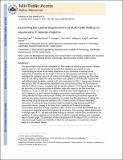| dc.contributor.author | Lee, Chia-Hua | |
| dc.contributor.author | Bose, Suman | |
| dc.contributor.author | Van Vliet, Krystyn J. | |
| dc.contributor.author | Karp, Jeffrey Michael | |
| dc.contributor.author | Karnik, Rohit | |
| dc.date.accessioned | 2013-05-14T15:59:01Z | |
| dc.date.available | 2013-05-14T15:59:01Z | |
| dc.date.issued | 2010-12 | |
| dc.date.submitted | 2010-10 | |
| dc.identifier.issn | 0743-7463 | |
| dc.identifier.issn | 1520-5827 | |
| dc.identifier.uri | http://hdl.handle.net/1721.1/78882 | |
| dc.description | Author Manuscript 2011 July 4. | en_US |
| dc.description.abstract | The lateral displacement of cells orthogonal to a flow stream by rolling on asymmetrical receptor patterns presents a new opportunity for the label-free separation and analysis of cells. Understanding the nature of cell rolling trajectories on such substrates is necessary to the engineering of substrates and the design of devices for cell separation and analysis. Here, we investigate the statistical nature of cell rolling and the effect of pattern geometry and flow shear stress on cell rolling trajectories using micrometer-scale patterns of biomolecular receptors with well-defined edges. Leukemic myeloid HL60 cells expressing the PSGL-1 ligand were allowed to flow across a field of patterned lines fabricated using microcontact printing and functionalized with the P-selectin receptor, leveraging both the specific adhesion of this ligand−receptor pair and the asymmetry of the receptor pattern inclination angle with respect to the fluid shear flow direction (α = 5, 10, 15, and 20°). The effects of the fluid shear stress magnitude (τ = 0.5, 1, 1.5, and 2.0 dyn/cm[superscript 2]), α, and P-selectin incubation concentration were quantified in terms of the rolling velocity and edge tracking length. Rolling cells tracked along the inclined edges of the patterned lines before detaching and reattaching on another line. The detachment of rolling cells after tracking along the edge was consistent with a Poisson process of history-independent interactions. Increasing the edge inclination angle decreased the edge tracking length in an exponential manner, contrary to the shear stress magnitude and P-selectin incubation concentration, which did not have a significant effect. On the basis of these experimental data, we constructed an empirical model that predicted the occurrence of the maximum lateral displacement at an edge angle of 7.5°. We also used these findings to construct a Monte Carlo simulation for the prediction of rolling trajectories of HL60 cells on P-selectin-patterned substrates with a specified edge inclination angle. The prediction of lateral displacement in the range of 200 μm within a 1 cm separation length supports the feasibility of label-free cell separation via asymmetric receptor patterns in microfluidic devices. | en_US |
| dc.description.sponsorship | Deshpande Center for Technological Innovation | en_US |
| dc.description.sponsorship | National Science Foundation (U.S.) (CAREER Award 0952493) | en_US |
| dc.description.sponsorship | National Institutes of Health (U.S.) (Grant DE019191) | en_US |
| dc.description.sponsorship | National Institutes of Health (U.S.) (Grant HL095722) | en_US |
| dc.description.sponsorship | National Institutes of Health (U.S.) (Grant HL097172) | en_US |
| dc.description.sponsorship | American Heart Association (Grant 0970178N) | en_US |
| dc.language.iso | en_US | |
| dc.publisher | American Chemical Society (ACS) | en_US |
| dc.relation.isversionof | http://dx.doi.org/10.1021/la102871m | en_US |
| dc.rights | Creative Commons Attribution-Noncommercial-Share Alike 3.0 | en_US |
| dc.rights.uri | http://creativecommons.org/licenses/by-nc-sa/3.0/ | en_US |
| dc.source | PubMed Central | en_US |
| dc.title | Examining the Lateral Displacement of HL60 Cells Rolling on Asymmetric P-Selectin Patterns | en_US |
| dc.type | Article | en_US |
| dc.identifier.citation | Lee, Chia-Hua, Suman Bose, Krystyn J. Van Vliet, Jeffrey M. Karp, and Rohit Karnik 2011Examining the Lateral Displacement of HL60 Cells Rolling on Asymmetric P-Selectin Patterns. Langmuir 27(1): 240–249. | en_US |
| dc.contributor.department | Massachusetts Institute of Technology. Department of Materials Science and Engineering | en_US |
| dc.contributor.department | Massachusetts Institute of Technology. Department of Mechanical Engineering | en_US |
| dc.contributor.mitauthor | Lee, Chia-Hua | |
| dc.contributor.mitauthor | Bose, Suman | |
| dc.contributor.mitauthor | Van Vliet, Krystyn J. | |
| dc.contributor.mitauthor | Karnik, Rohit | |
| dc.relation.journal | Langmuir | en_US |
| dc.eprint.version | Author's final manuscript | en_US |
| dc.type.uri | http://purl.org/eprint/type/JournalArticle | en_US |
| eprint.status | http://purl.org/eprint/status/PeerReviewed | en_US |
| dspace.orderedauthors | Lee, Chia-Hua; Bose, Suman; Van Vliet, Krystyn J.; Karp, Jeffrey M.; Karnik, Rohit | en |
| dc.identifier.orcid | https://orcid.org/0000-0003-0588-9286 | |
| dc.identifier.orcid | https://orcid.org/0000-0002-5921-3436 | |
| dc.identifier.orcid | https://orcid.org/0000-0001-5735-0560 | |
| dspace.mitauthor.error | true | |
| mit.license | OPEN_ACCESS_POLICY | en_US |
| mit.metadata.status | Complete | |
